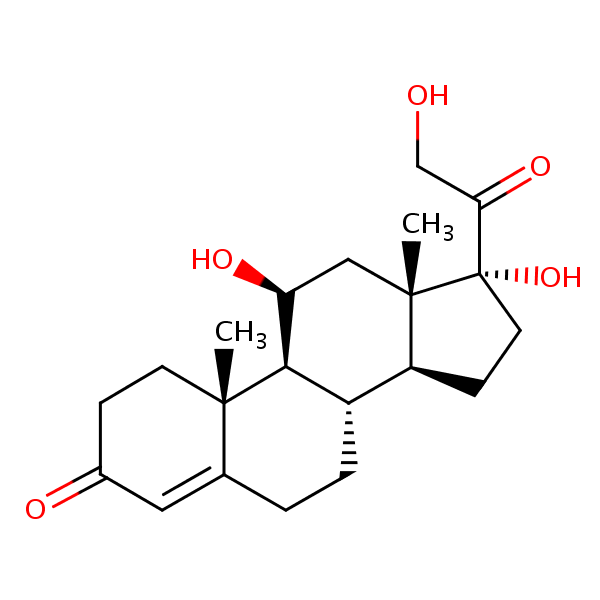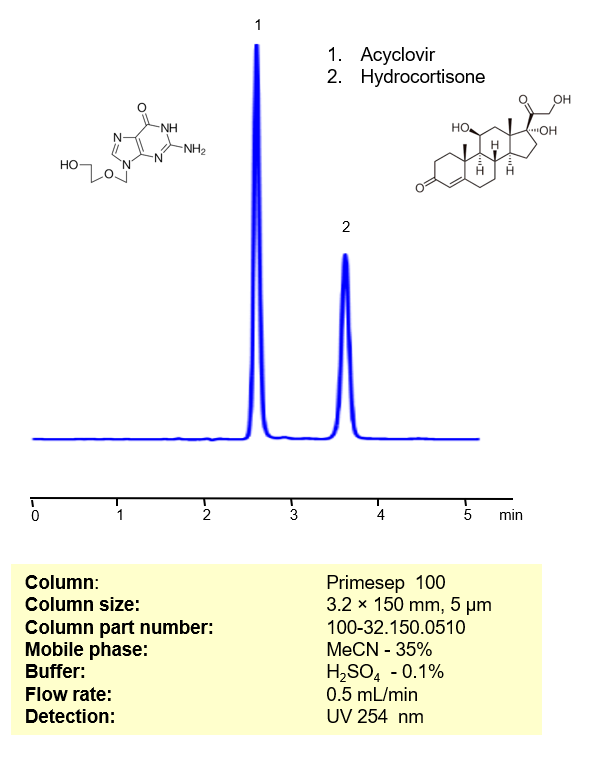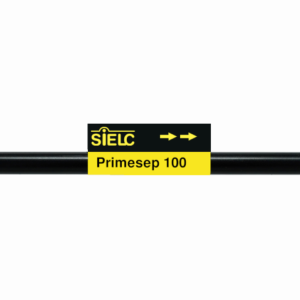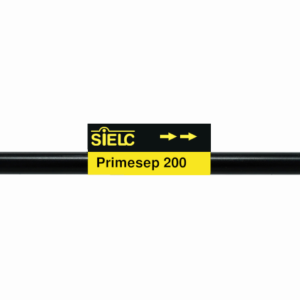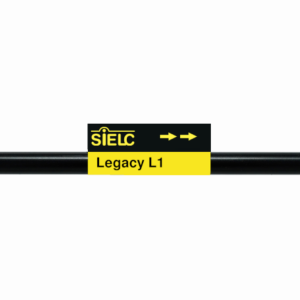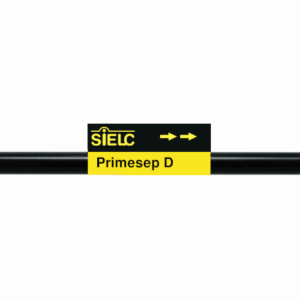| CAS Number | 50-23-7 |
|---|---|
| Molecular Formula | C21H30O5 |
| Molecular Weight | 362.467 |
| InChI Key | JYGXADMDTFJGBT-VWUMJDOOSA-N |
| LogP | 1.61 |
| Synonyms |
|
Applications:
HPLC Method for Simultaneous Determination of Acyclovir and Hydrocortisone on Primesep 100 Column
August 31, 2022
Separation type: Liquid Chromatography Mixed-mode
High Performance Liquid Chromatography (HPLC) Method for Analysis of Acyclovir and Hydrocortisone
Acyclovir is used to treat viral infections caused by a group of viruses called herpes simplex viruses. These infections include oral and genital herpes, as well as shingles. It can also be used to treat chickenpox in children. Hydrocortisone, or cortisol, is a common corticosteroid used to treat a wide variety of ailments, including high blood calcium, arthritis, dermatitis, and asthma, among others. Both of these drugs can be separated, retained, and analyzed on a Primesep 100 mixed-mode column using an isocratic analytical method with a simple isocratic mobile phase of water, Acetonitrile (MeCN), and a sulfuric acid (H2SO4) buffer. This analysis method can be UV detected at 254 nm with high resolution and peak symmetry.| Column | Primesep 100, 3.2×150 mm, 5 µm, 100A |
| Mobile Phase | MeCN – 35% |
| Buffer | H2SO4 – 0.1% |
| Flow Rate | 0.5 ml/min |
| Detection | UV 254 nm |
| Class of Compounds | Drug |
| Analyzing Compounds | Acyclovir and Hydrocortisone |
Application Column
Primesep 100
The Primesep family of mixed-mode columns offers a wide variety of stationary phases, boasting unprecedented selectivity in the separation of a broad array of chemical compounds across multiple applications. Corresponding Primesep guard columns, available with all stationary phases, do not require holders. SIELC provides a method development service available to all customers. Inquire about our specially-tailored custom LC-phases for specific separations.
Select optionsHydrocortisone

HPLC Method for Analysis of Hydrocortisone
May 3, 2016
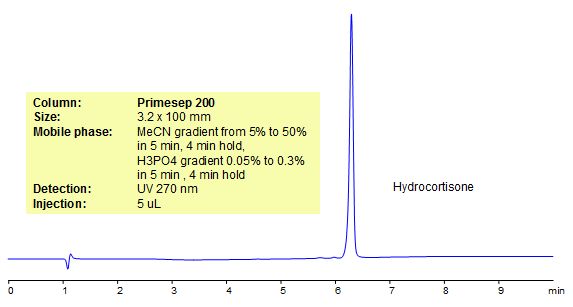
Hydrocortisone, also known as 11β,17α,21-trihydroxypregn-4-ene-3,20-dione, is a corticosteroid, is similar to a natural hormone produced by your adrenal glands. It is used to treat certain forms of arthritis as well various skin conditions (redness, swelling, and itching). Primesep 200, a reverse phase column, contains embedded acidic ionizable groups and can retain Hydrocortisone. The method is UV compatible and can be used as a general approach for analyzing similar compounds.
Application Column
Primesep 200
The Primesep family of mixed-mode columns offers a wide variety of stationary phases, boasting unprecedented selectivity in the separation of a broad array of chemical compounds across multiple applications. Corresponding Primesep guard columns, available with all stationary phases, do not require holders. SIELC provides a method development service available to all customers. Inquire about our specially-tailored custom LC-phases for specific separations.
Select optionsHPLC Method for Analysis of Hydrocortisone
HPLC Separation of Hydrocortisone and Hydrocortisone’s Degradation Products
Hydrocortisone

HPLC Ananlysis of Hydrocortisone
July 31, 2015
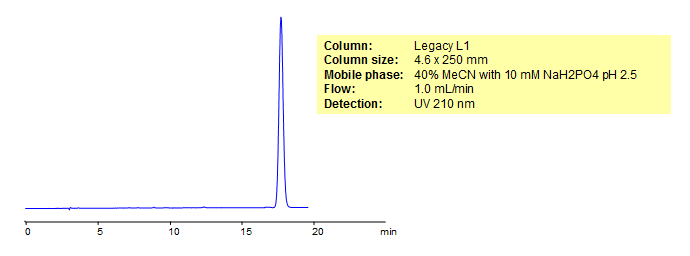
Hydrocortisone is the drug form of the steroid hormone cortisol. Cortisol is an important biological molecule which affects blood sugar, metabolism and the immune system. It was retained on the reverse-phase column Legacy L1. Comparisons of Legacy L1 and Phenomenex columns are available by request.
| Column | Legacy L1, 4.6×250 mm, 5 µm, 100A |
| Mobile Phase | MeCN – 40% |
| Buffer | NaH2PO4 pH 2.5 – 10 mM |
| Flow Rate | 1.0 ml/min |
| Detection | UV, 210 nm |
| Class of Compounds |
Hormone, Hydrophobic, Ionizable |
| Analyzing Compounds | Hydrocortisone |
&
Application Column
Legacy L1
SIELC's family of Legacy columns is based on the United States Pharmacopeia's (USP) published chromatographic methods and procedures. Numerous brands have columns used in USP reference standards and methods. USP has created various designations to group together columns with similar types of packing and properties in the solid phase. SIELC's Legacy columns adhere to these strict requirements and properties, allowing you to easily replace older columns that are no longer available without needing to significantly modify your method or SOPs.
Select options
USP Methods for the Analysis of Hydrocortisone on a Legacy L1 Column
June 21, 2012

Application Notes: Hydrocortisone is a naturally occurring hormone released during times of stress. Hydrocortisone has been synthesized and is used to treat diseases such as allergic reactions and skin conditions. According to the USP methods, hydrocortisone contains not less than 97 percent and not more than 102 percent of hydrocortisone calculated on the dried basis. The USP HPLC method for the separation of hydrocortisone was developed on Legacy L1 column according to the US Pharmacopeia methodology. L1 classification is assigned to reversed-phase HPLC column containing C18 ligand. Support for the material is spherical silica gel with particles size 3-10 um and pore size of 100-120A.
Application Columns: Legacy L1 C18 HPLC column
Application compounds: Hydrocortisone
Mobile phase: MeCN/H2O 25:75
Detection technique: UV
Reference: USP30: NF35
| Column | Legacy L1, 4.6×150 mm, 5 µm, 100A |
| Mobile Phase | NaH2PO4 pH 7.0/MeCN 88/12 |
| Buffer | NaH2PO4 |
| Flow Rate | 1.0 ml/min |
| Detection | UV, 254 nm |
| Class of Compounds |
Drug, Antibiotics, Hydrophobic, Ionizable |
| Analyzing Compounds | Nitrofurantoin |
Application Column
Legacy L1
SIELC's family of Legacy columns is based on the United States Pharmacopeia's (USP) published chromatographic methods and procedures. Numerous brands have columns used in USP reference standards and methods. USP has created various designations to group together columns with similar types of packing and properties in the solid phase. SIELC's Legacy columns adhere to these strict requirements and properties, allowing you to easily replace older columns that are no longer available without needing to significantly modify your method or SOPs.
Select options
HPLC Separation of Hydrocortisone and Hydrocortisone’s Degradation Products
March 27, 2011
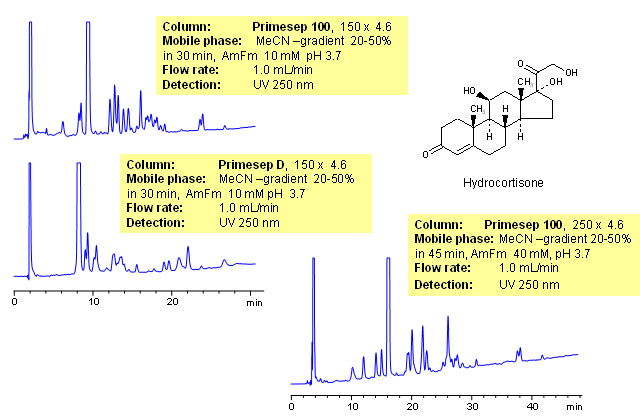
Cortisol (hydrocortisone) is a steroid hormone produced by the adrenal gland. Hydrocortisone is a hydrophobic neutral compound with some polar groups in its structure. Several Primesep mixed-mode columns were used for separation of hydrocortisone and its degradation products. Each column showed a different selectivity for separation, which attributed to different polar-embedded groups on Primesep 100 and Primesep D columns. Both columns can be used for degradation studies of various hydrophobic compounds.
Application Column
Primesep 100
The Primesep family of mixed-mode columns offers a wide variety of stationary phases, boasting unprecedented selectivity in the separation of a broad array of chemical compounds across multiple applications. Corresponding Primesep guard columns, available with all stationary phases, do not require holders. SIELC provides a method development service available to all customers. Inquire about our specially-tailored custom LC-phases for specific separations.
Select optionsPrimesep D
The Primesep family of mixed-mode columns offers a wide variety of stationary phases, boasting unprecedented selectivity in the separation of a broad array of chemical compounds across multiple applications. Corresponding Primesep guard columns, available with all stationary phases, do not require holders. SIELC provides a method development service available to all customers. Inquire about our specially-tailored custom LC-phases for specific separations.
Select optionsHydrocortisone

